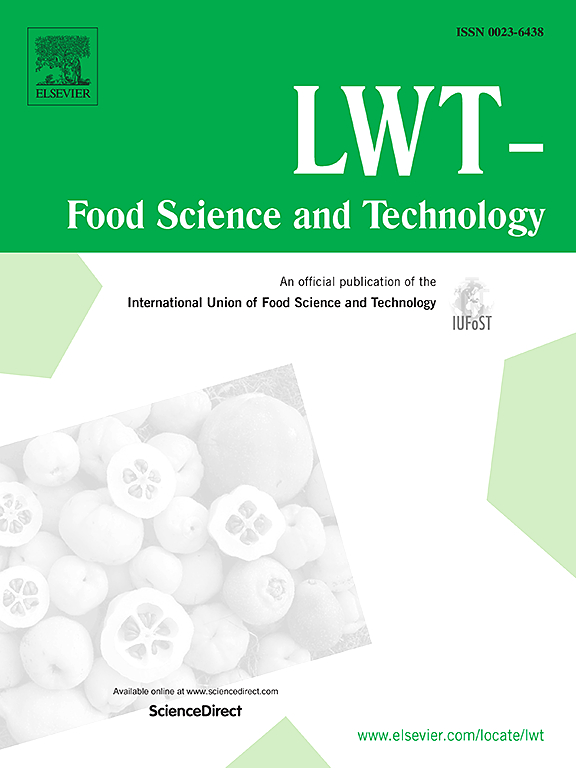共色素对草莓酒颜色影响的代谢组学分析
IF 6.6
1区 农林科学
Q1 FOOD SCIENCE & TECHNOLOGY
引用次数: 0
摘要
草莓酒的鲜艳颜色主要来自花青素,在储存过程中由于氧化、温度波动和酶的活性而容易降解,从而降低了视觉吸引力和价值。多酚类黄酮类化合物通过抗氧化作用和花青素的共同着色,提供了增强颜色稳定性的潜力。研究了没食子酸、芦丁和香草酸对草莓酒颜色稳定性的影响。发酵前添加的芦丁(Pre-Rutin)显著提高了稳定性,增加了红色、黄色和亮度,使外观更有活力。巴氏灭菌后多酚含量最初因细胞破坏和生化反应而激增,后来由于微生物和化学活动占主导地位而下降或稳定。花青素含量对储存条件敏感,随着时间的推移,由于降解因素而降低,导致颜色褪色。靶向代谢组学显示,芦丁对特定花青素衍生物的合成具有深远的促进作用:与对照相比,芦丁组花青素-3- o -槐苷含量高16.37倍,花青素-3- o -(6″- o -琥珀酰)半乳糖苷含量高7.9倍,花青素-3- o -阿拉伯糖苷含量高4.3倍。本研究首次证明发酵前添加芦丁通过催化关键花青素的形成显著提高草莓酒的颜色稳定性(ΔE<5)。关键是,芦丁改变了花青素的组成,抑制了不稳定的非酰化形式,同时促进了稳定的酰化和特异性糖基化衍生物(特别是花青素-3- o - sophoside,花青素-3- o -(6″- o -琥珀酰)半乳糖苷和花青素-3- o -阿拉伯糖苷)。这种向更稳定的花青素结构的转变显著提高了整体颜色的稳定性。本文章由计算机程序翻译,如有差异,请以英文原文为准。
Targeted metabolomics analysis of the impact of co-pigment on the color of strawberry wine
The vibrant color of strawberry wine, primarily from anthocyanins, is susceptible to degradation during storage due to oxidation, temperature fluctuations, and enzymatic activity, diminishing visual appeal and value. Polyphenolic flavonoids offer potential for enhancing color stability through antioxidant effects and anthocyanin co-pigmentation. This study investigated gallic acid, rutin, and vanillic acid for improving strawberry wine color stability. Pre-fermentation rutin addition (Pre-Rutin) significantly enhanced stability, increasing redness, yellowness, and brightness, resulting in a more vibrant appearance. Post-pasteurization polyphenol content initially surged due to cellular disruption and biochemical reactions, later declining or stabilizing as microbial and chemical activities dominated. Anthocyanin content, sensitive to storage conditions, decreased over time from degradation factors, leading to color fading. Targeted metabolomics revealed that rutin profoundly facilitates the synthesis of specific anthocyanin derivatives: Pelargonidin-3-O-sophoroside content was 16.37 times higher, Cyanidin-3-O-(6″-O-succinyl) galactoside 7.9 times higher, and Cyanidin-3-O-arabinoside 4.3 times higher in the Rutin group versus the CK. This study demonstrates for the first time that pre-fermentation rutin addition significantly enhances strawberry wine color stability (ΔE<5) by catalyzing the formation of key anthocyanins. Crucially, rutin alters anthocyanin composition, inhibiting unstable non-acylated forms while promoting stable acylated and specifically glycosylated derivatives (notably Pelargonidin-3-O-sophoroside, Cyanidin-3-O-(6″-O-succinyl) galactoside and Cyanidin-3-O-arabinoside). This shift towards more stable anthocyanin structures significantly enhances overall color stability.
求助全文
通过发布文献求助,成功后即可免费获取论文全文。
去求助
来源期刊

LWT - Food Science and Technology
工程技术-食品科技
CiteScore
11.80
自引率
6.70%
发文量
1724
审稿时长
65 days
期刊介绍:
LWT - Food Science and Technology is an international journal that publishes innovative papers in the fields of food chemistry, biochemistry, microbiology, technology and nutrition. The work described should be innovative either in the approach or in the methods used. The significance of the results either for the science community or for the food industry must also be specified. Contributions written in English are welcomed in the form of review articles, short reviews, research papers, and research notes. Papers featuring animal trials and cell cultures are outside the scope of the journal and will not be considered for publication.
 求助内容:
求助内容: 应助结果提醒方式:
应助结果提醒方式:


